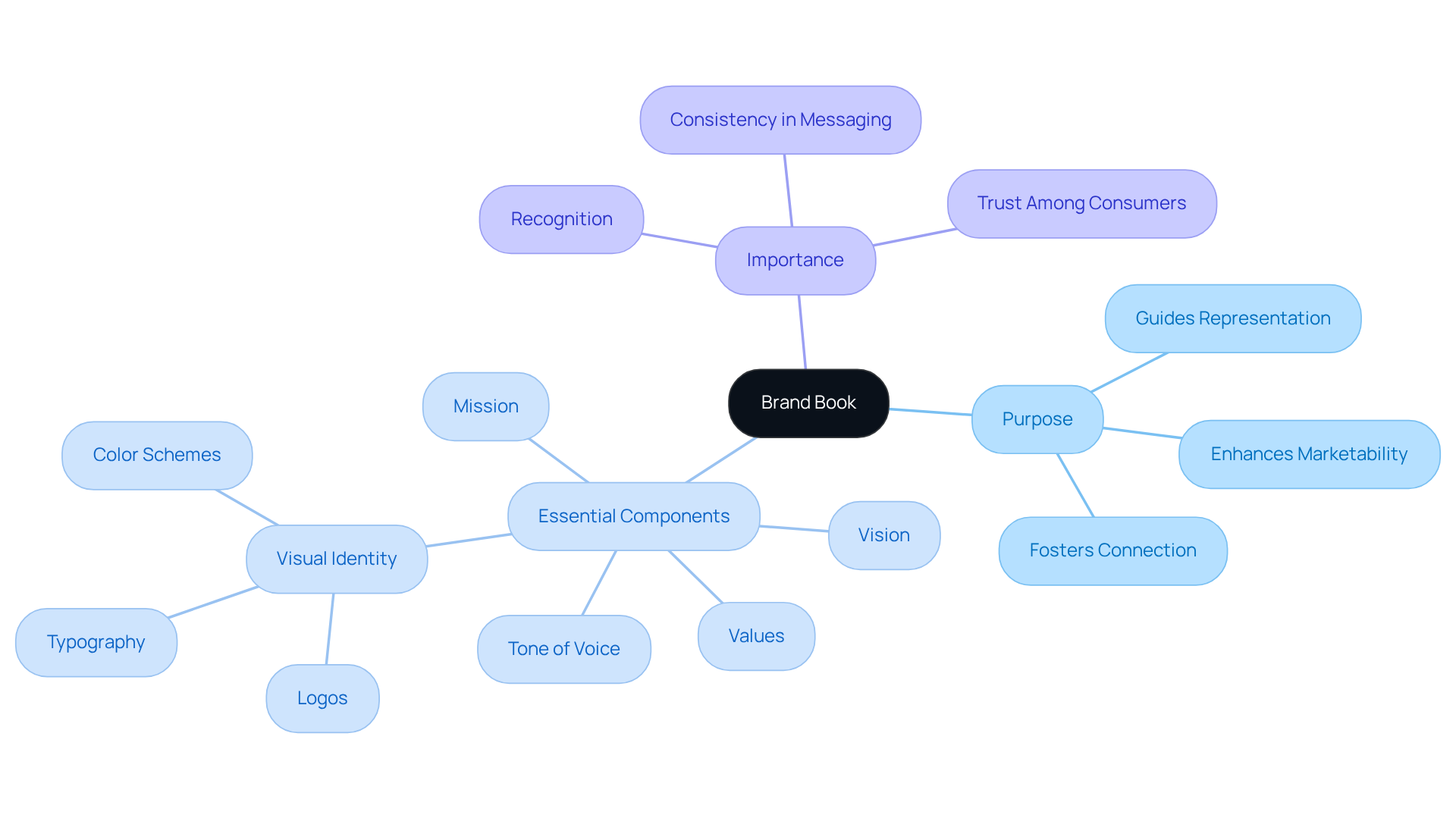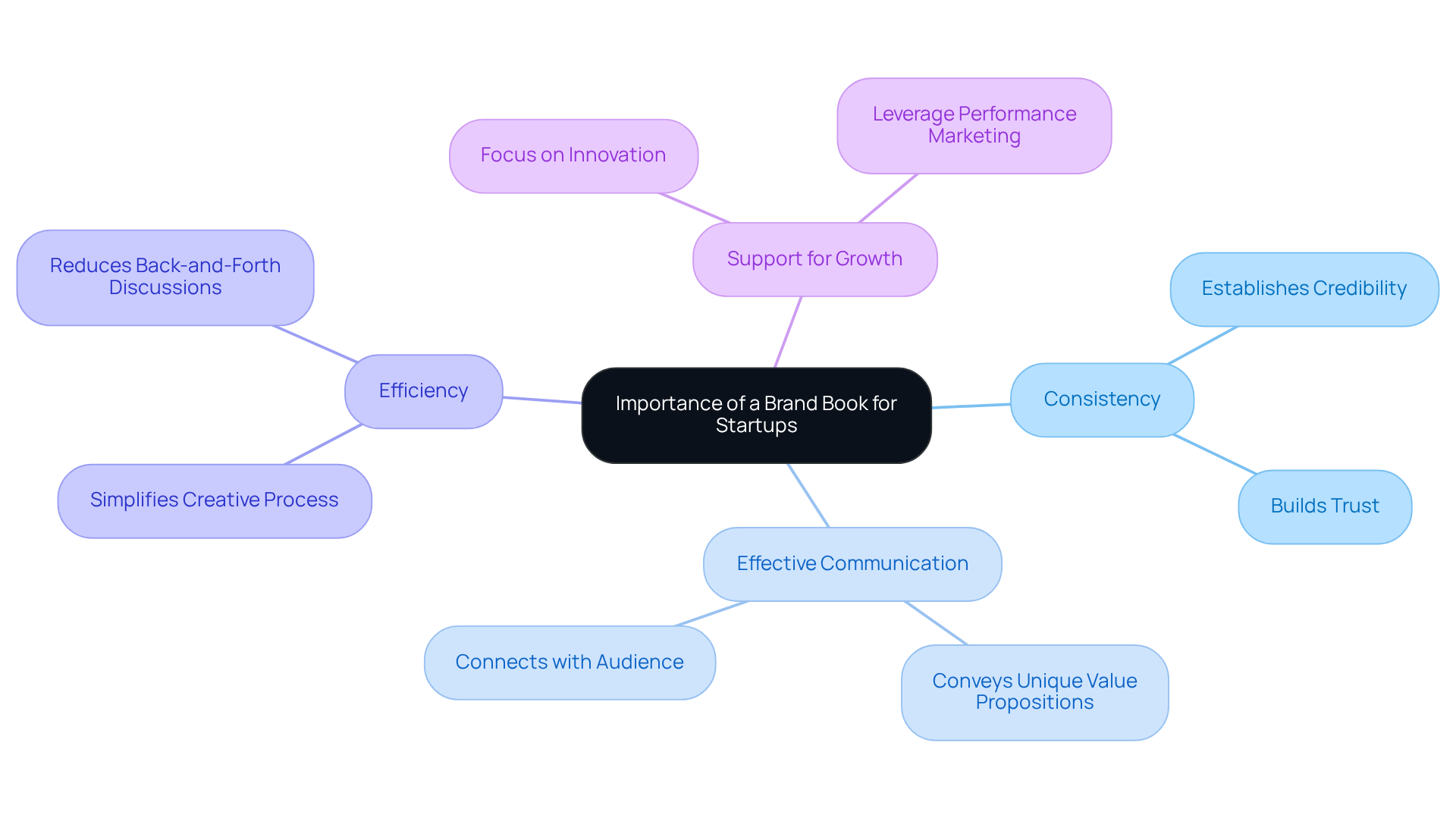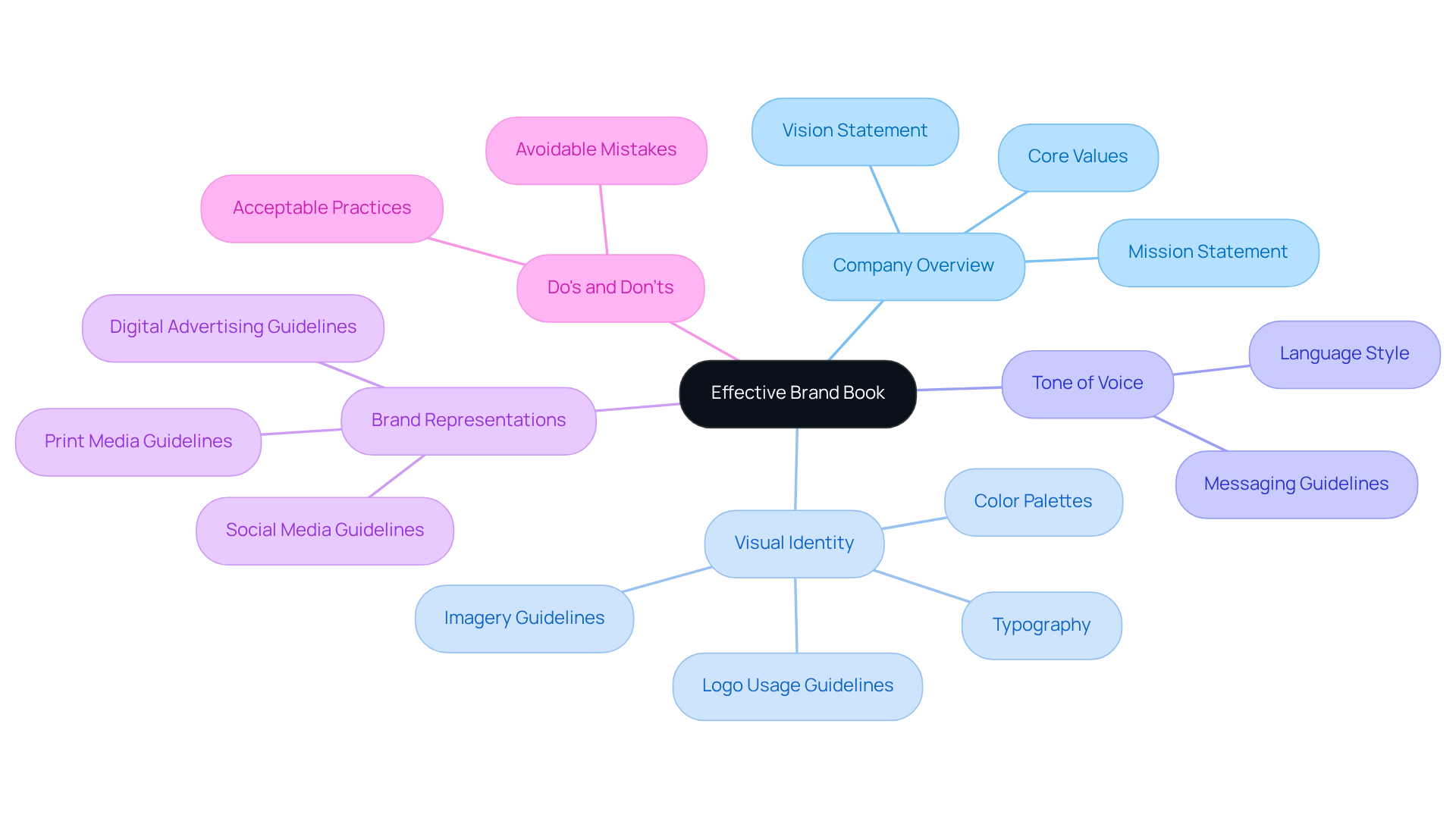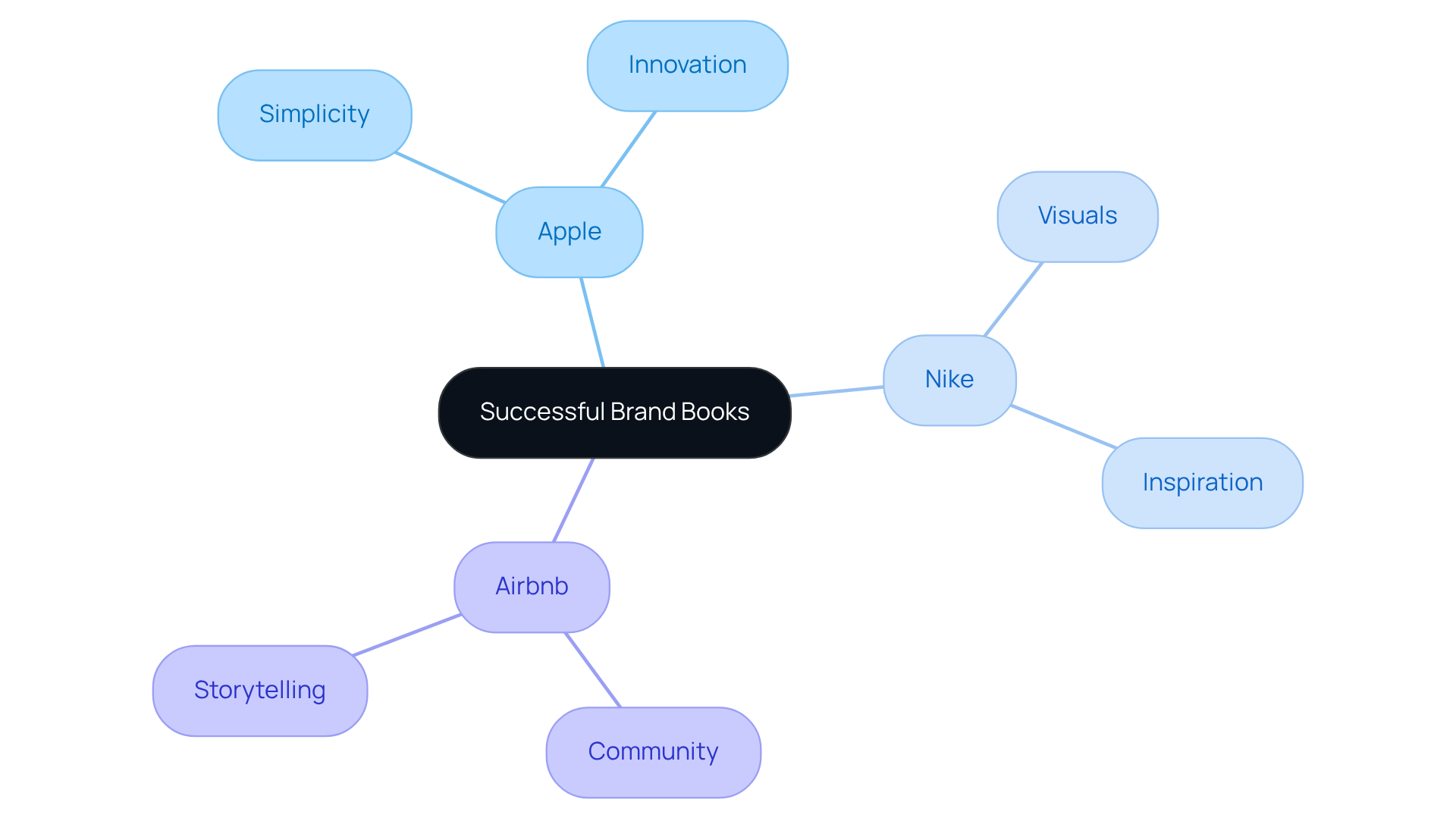Overview
The article highlights the challenges that many startups face in establishing a consistent brand identity, a crucial element in their journey. Without a solid foundation, these companies may struggle to convey their unique value propositions, leading to confusion and mistrust among consumers. This inconsistency can be a painful hurdle, as it often results in missed opportunities for connection and growth.
To address this, the article emphasizes the importance of a brandbook as a nurturing resource for startups. A well-crafted brandbook serves as a guiding light, detailing essential components such as:
- Company overview
- Visual identity
- Tone of voice
These elements work together to foster a cohesive brand image, helping startups build trust and resonate with their audience.
By sharing stories of successful companies that have embraced this approach, the article illustrates how a thoughtful brandbook can empower startups to articulate their vision and values effectively. It invites readers to consider their own experiences and reflect on how a brandbook could serve as a supportive tool in their branding journey. Ultimately, this resource not only enhances consistency in branding and messaging but also nurtures a sense of community and connection with consumers.
Introduction
A brandbook serves as the backbone of a company's identity, encapsulating its mission, vision, and values while guiding its visual and verbal representation. For startups, this resource is not merely beneficial; it is crucial for establishing credibility and fostering meaningful connections in a crowded marketplace. Many founders, however, find themselves grappling with how to effectively communicate their unique value propositions. This struggle can feel isolating and overwhelming, as the noise of competition drowns out their voices.
Yet, there is hope. A well-crafted brandbook can transform a startup's narrative, ensuring it stands out amidst the noise and resonates with its audience. By embracing this essential tool, founders can not only articulate their vision but also forge deeper connections with their customers, creating a lasting impact in their industry.
Define the Brand Book: Essential Concepts and Purpose
A brandbook, often referred to as a guide or style guide, serves as a vital resource that encapsulates the essence of a company. It provides direction on how the company should be represented in its brandbook across various platforms and mediums. This brandbook typically outlines the organization's mission, vision, values, visual identity—such as logos, color schemes, and typography—and tone of voice. Without this framework, companies may struggle with and visual representation outlined in their brandbook, which can hinder recognition and trust among consumers.
At RNO1, we understand that a thoughtfully crafted guide is essential for enhancing marketability through our Return On Design & Digital (RODD) strategies. Our design-centered approach, paired with strategic partnerships, empowers contemporary brands to create transformative digital experiences that resonate across platforms. We believe that every interaction should reflect the core essence of the company, fostering a genuine connection with the audience.

Explore the Importance of a Brand Book for Startups
For startups, having a brandbook is not just a luxury; it is essential. Many founders struggle to convey their unique value propositions effectively, leading to missed opportunities in a competitive landscape. This challenge can feel overwhelming, especially for those who are passionate about their ideas but unsure how to communicate them. RNO1's strategic rebranding of Founder's Haven serves as a powerful example of how a well-designed brandbook can empower contemporary founders. It helps them connect meaningfully in the digital landscape, ensuring they are not lost in the noise.
A thorough brandbook promotes consistency across all marketing materials, which is crucial for establishing credibility and trust with prospective clients and investors. Without this consistency, startups may find themselves facing skepticism, which can hinder growth. Moreover, a clear brandbook simplifies the creative process, allowing teams to generate content that aligns with the company's values without extensive back-and-forth discussions. This efficiency is particularly beneficial for startups with limited resources, enabling them to focus on what truly matters: growth and innovation.
As you navigate your journey, remember that leveraging performance marketing strategies can help hyper-scale your eCommerce efforts. Embracing a thoughtful branding approach, as outlined in your brandbook, is not just about aesthetics; it’s about creating a strong foundation that supports your vision and connects with your audience. You are not alone in this; many founders have walked this path and found success by . Let RNO1 guide you through this transformative process, ensuring you can thrive in the ever-evolving marketplace.

Identify Key Elements of an Effective Brand Book
Creating a strong brand can often feel overwhelming for tech startup founders. With so many elements to consider, it’s easy to feel lost in the details. However, an effective brandbook can be your guiding light, ensuring consistency and clarity in your branding efforts. It should include several key elements that address these challenges:
- Company Overview: Begin with a heartfelt summary of your organization’s mission, vision, and values. This foundation will resonate with your audience and set the tone for your brand.
- : Next, provide clear guidelines for logo usage, color palettes, typography, and imagery. These elements will visually communicate your brand’s essence and foster recognition.
- Tone of Voice: It’s essential to outline how to convey your identity’s personality through language and messaging. This will help ensure that your communications feel authentic and relatable.
- Brand Representations: Illustrate how your identity should be showcased across various platforms, including social media, print, and digital advertising. Consistency here builds trust and familiarity.
- Do's and Don'ts: Lastly, offer clear guidelines on what is acceptable and what should be avoided in representation. This clarity will empower your team to make confident branding decisions.
By incorporating these elements, you can create a comprehensive brandbook that addresses the common pain points of branding while nurturing your brand’s identity with compassion and care.

Examine Examples of Successful Brand Books
For many startup founders, crafting a compelling brand narrative can feel daunting. The challenge lies in effectively connecting with audiences while staying true to their unique identity. This is where the exemplary publications from renowned companies like Apple, Nike, and Airbnb come into play.
- Apple's guide is a beacon of simplicity and innovation, beautifully reflecting its core values.
- Nike's guide empowers its readers through striking visuals and inspiring language, creating a sense of athleticism that resonates deeply.
- Meanwhile, Airbnb’s guide emphasizes community and belonging, encouraging genuine storytelling that fosters connection.
By examining these successful examples, you can uncover valuable insights that will help you create your own brandbook. This resource can and authentically represent your startup's identity. Remember, you are not alone in this journey; by learning from the successes of others, you can craft a narrative that speaks to the heart of your audience.

Conclusion
A brandbook is an invaluable asset for any organization, acting as a comprehensive guide that embodies its identity and ensures consistency across all communication channels. It outlines essential elements such as mission, vision, visual identity, and tone of voice, enabling businesses to maintain a cohesive representation that fosters trust and recognition among consumers.
For many startups, the significance of a well-crafted brandbook cannot be overstated. It not only assists in articulating unique value propositions but also streamlines the creative process, allowing teams to focus on growth and innovation. Imagine the relief of having a clear company overview, visual identity guidelines, and tone of voice at your fingertips. These key components empower startups to navigate branding challenges with confidence. Moreover, looking at successful brandbooks from industry leaders can provide valuable insights that inspire emerging brands to craft their own impactful narratives.
Ultimately, embracing the principles of a thoughtful brandbook is essential for establishing a strong foundation that resonates with audiences and supports business objectives. As startups embark on their journeys, prioritizing their brand identity can lead to greater market presence and deeper connections with consumers. By learning from successful examples and implementing effective branding strategies, businesses can thrive in an increasingly competitive landscape, fostering a sense of community and support along the way.
Frequently Asked Questions
What is a brand book?
A brand book, also known as a guide or style guide, is a vital resource that encapsulates the essence of a company and provides direction on how the company should be represented across various platforms and mediums.
What key elements are typically included in a brand book?
A brand book typically includes the organization's mission, vision, values, visual identity (such as logos, color schemes, and typography), and tone of voice.
Why is a brand book important for a company?
A brand book is important because it helps maintain consistency in messaging and visual representation, which is crucial for building recognition and trust among consumers.
How does RNO1 approach brand book creation?
RNO1 takes a design-centered approach, utilizing their Return On Design & Digital (RODD) strategies, to create thoughtfully crafted guides that enhance marketability and foster genuine connections with the audience.
What is the impact of a well-crafted brand book on digital experiences?
A well-crafted brand book empowers contemporary brands to create transformative digital experiences that resonate across platforms, ensuring that every interaction reflects the core essence of the company.




